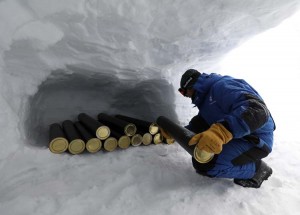Ice Memory: A Glacier Archive
Wednesday, July 12th, 2017July 12, 2017
Last month, in June, an international team of researchers and scientists braved heavy snows, freezing winds, and thin air to extract ice core samples from the Illimani glacier high in the Andes Mountains of Bolivia. The samples were the latest collected by teams from Ice Memory, a project aiming to gather ice samples from endangered glaciers around the world. The archive—which will be stored in a sanctuary in Antarctica—will allow future studies of glaciers that will soon fall victim to global warming. Ice Memory is managed by the University of Grenoble Alps Foundation in France and supported by the French and Italian national commissions for the United Nations Educational, Scientific and Cultural Organization (UNESCO).

On June 6, 2017, the Ice Memory team drills near their camp on the Illimani glacier in the Andes Mountains of Bolivia. Credit: © Sarah Del Ben, Wiltouch/Fondation UGA
At 21,004 feet (6,402 meters), Illimani is the highest mountain in the Cordillera Real range of western Bolivia. Glaciers on Illimani have existed for many thousands of years, but they are rapidly melting and retreating as climate change increases Earth’s temperatures. Glacier ice reads like a historical record of climate and environment, preserving ancient animal, plant, and mineral samples as well as showing glacial growth over millennia. They also show variations in temperatures and more recent concentrations of greenhouse gases and other pollutants. Saving Illimani cores will allow scientists to study the ice long after the host glaciers have disappeared.

Scientists remove ice from the drilling core on the Illimani glacier in Bolivia on June 9, 2017. Credit: © Sarah Del Ben, Wiltouch/Fondation UGA
It took several weeks for the Illimani team to drill through the ice and extract the core samples, both of which were more than 440 feet (135 meters) long. Dangerous weather forced the team to abandon the planned retrieval of a third sample. The glacier cores were then cut into smaller pieces, stored in tubes, and catalogued. The samples will eventually make their way to the archive at Concordia Station in Antarctica, where they will join the first core samples extracted from France’s Mont Blanc in 2016. The Concordia glacier archive is meant to store hundreds of ice core samples in a protected snow cave at -65° Fahrenheit (-54° Celsius).

An Ice Memory researcher stacks tubed sections of ice core in an improvised snow cave on the Illimani glacier on June 5, 2017. The samples will eventually be stored in Antarctica. Credit: © Sarah Del Ben, Wiltouch/Fondation UGA
Future core extractions are planned for such threatened glacier areas as Mera Peak in Nepal, Mount Elbrus in Russia, Mount Kilimanjaro in Tanzania, and sites in the Swiss Alps and the Altai Mountains in Asia. Ideally, three glacier samples from each area will provide one sample for immediate analysis and two for storage and archiving. Aside from providing clues about the past, the samples help scientists understand the current effects of climate change and predict future environmental events.


